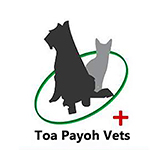 TOA
PAYOH VETS TOA
PAYOH VETStoapayohvets.com Blk 1002, Toa Payoh Lor 8, 01-1477,
Singapore 319074. Tel: +65
6254-3326,
9668-6468,
judy@toapayohvets.com,
99pups@gmail.com |
|
Toa Payoh Vets Clinical Research Making veterinary surgery alive to a veterinary student studying in Australia using real case studies and pictures
URINARY STONES AND SEIZURES IN A MALTESE |
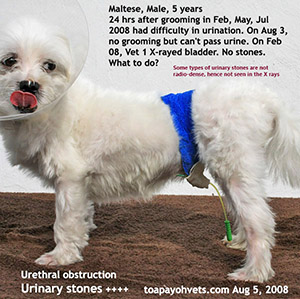 |
|
AUGUST 2, 2008
"If your car can't move after returning from the mechanic, what do you expect?" the trim man in his 60s asked me as I was about the leave the Surgery at the end of a long day. Without waiting for my reply, Mr Lee said, "Surely you expect the mechanic to repair your car till you can drive it. Free of charge!" A veterinarian who had warded his dog for 3 days had released the dog to him. "Look, look, no urine came out," the man directed my attention to the small mini-Maltese cocking his right leg against the wall of a column for a few seconds. "This is the first time I see your dog. I don't know anything about your dog treatment," I did not wish to get involved with potential litigation. "You will have to talk to your vet." I went back to the back room to collect my things. Mr Lee's knuckles rapped on the glass panels of the front of the Surgery to attract the attention of Mr Saw, my vet technician who was at the waiting area doing some administration work. "Ta boleh kenching! (Cannot urinate in Malay)," he cricked his knuckles onto the glass panels and shouted from outside. I went out of the Surgery: "No point talking to Mr Saw. He is not a veterinarian in Singapore. He does not speak the Malay language. He is a Myanmar National." Mr Saw had been mistaken for an Indian and now as a Malay as he has sun burnt tanned skin. If possible, I would help to resolve any dispute affecting the veterinary profession even if the veterinarian is from the competition. I spent some time finding out what Mr Lee wanted. "All my money back," he said. "After all, the dog still cannot pee and I had paid the fees. If your car goes to the mechanic and he cannot repair your car, you ought to get your money back." Mr Lee lectured the roles and responsibilities of the mechanic. Non performance, money back guarantee. "Well," I said. "You really have to speak to your vet directly if you want your money back. I don't know what really happened." Mr Lee said, "I understand that this vet had a business to run and has his overheads." He waved a veterinary bill for me to see, "I don't know whether he had really given the drugs or treatment to my dog. Vet 1 (the first vet) who treated him had said there was no bladder stones and after his X-ray, the dog could pee normally for some weeks. "On another occasion, I went to Vet 1. He prescribed some antibiotics without seeing the dog. The dog could pee normally. Last week Vet 1 refused to give me the antibiotics. He wanted me to bring the dog down for examination. I consulted Vet 2 because he is nearer to my home." "Mr Lee," I did not want to comment on the actions of other professionals. "How much money do you want back from Vet 2?" "All my money," Mr Lee said. I shook my head, "Vet 2 had spent time and did work on your dog. I don't know what he advised you. The only thing I can do for you is to phone him and ask him for some money back for you." Mr Lee nodded his head. Vet 2 said to me when I phoned, "Mr Lee had contacted me some 20 times. The dog has urinary stones and need a cystotomy." Cystotomy is to open up the bladder to remove the stones. "Can you give him back some money so as to resolve the matter?" I saw the sun had set and it was none of my business. "Try to nNegotiate." Vet 2 roared in a low rumbling tone, "I am non-negotiable." "Negotiation is the best way in this case. Give Mr Lee a counter-offer," I urged Vet 2. "This dispute can be resolved with money and you will never see Mr Lee again." I advised. I did not want to say much about the ugliness of veterinary investigation by the authorities and prospective litigation as all veterinarians in practice would have had suffered some time or another. I presumed Vet 2 had never encountered such unpleasantness and time expended to attend to complaints personally. However, giving money back is perceived by some owners as admission of guilt or negligence. That was Vet 2's position. Still I advised him to give back some money. "You will avoid all unpleasantness and paperwork of veterinary investigation and litigation. It would cost more than $1,000 to engage a lawyer to defend yourself. How about the tremendous amount of time involved in administrative work during investigation?" Here we were talking of giving back around $100 back to the owner who equated a vet to a car mechanic---money back if the car can't start. "50% back," Vet 2 said. I conveyed the message to Mr Lee. "80%," Mr Lee said. I asked Mr Lee to sit on the chair and talked to him. "Vet 2 had told you that your dog had bladder stones. Even though Vet 1 had said there were no bladder stones some months ago and that antibiotics cured the dog, it is Vet 2's diagnosis that the dog has bladder stones. Veterinary surgery for bladder stone removal and other tests would be expensive and can be as much as $1,500." Mr Lee accepted partial return of his money. He did not want to pay for more veterinary tests or treatment and hence Vet 2 had charged him for consultation and some costs. Mr Lee turned to me and grinned: "I do not want surgery to remove the bladder stones. I sell this dog to you," "I do not buy dogs. In any case, i am sorry to say that a 4-year-old mini-Maltese has no commercial value. As a puppy he might sell for $800 but once adult, very rarely will anybody pay to buy him." Mr Lee grumbled about the cost of living in Singapore. I listened to his tirades against the government increasing the utilities and making life difficult for the ordinary man. "Veterinary expenses for a dog is much lower than bringing up a child," I said. "When children grow up, they don't pay the parents back the large amounts of money spent on educating them. They have their families to support and so do not give any allowance to their parent. Some even asked the aged parent to part with their savings in the CPF (Central Provident Fund. Is that right, James?" James is a 73-year-old working as a receptionist for me. He had used his CPF money for his son to buy an Housing Development Board apartment but the daughter-in-law did not welcome him to stay there. So he had to go back to Kluang in Malaysia during his days off. James nodded his head. "No, no" Mr Lee disagreed, shaking his head vigorously. "My son gives me money." "You are one fortunate father," I said. It was past 7 p.m. A lady in shimmering brown dress and high heels was seen at the glass panels of the entrance. She walked in. "Look at this pretty lady," I pointed to the young woman well dressed and in the prime of her life. "Her dog had urinary stones and could not pass urine 2 months ago. Then after the operation to remove all stones, the dog could pass urine 3 days ago. Now she is taking her dog home from the Surgery. She spent a lot of money on treating him. But he might have problems not being able to pee again." I gave some instructions to the young woman as to how to care for her Miniature Schnauzer. She rolled her eyes upwards as she read a long lists of what to do to prevent recurrence by making sure that the dog drinks more water and pee more often. Also to give prescription diets on medical dissolution of the struvite stones and to send the urine for analysis and X-rays yearly to the Surgery. (History: Her dog had a cystotomy to remove a large 7-mm bladder stone and >100 small sandy ones some 2 months ago. This time she consulted me immediately on seeing dysuria in her dog. Urine analysis show struvite +. Urine sample taken by catherisation in front of the owner showed a few sandy crystals in the urine. X-rays were negative for visible stones). Mr Lee was watching intently. She paid the balance of around $600 inclusive of the X-rays and 20 cans of Hills' S/D prescription diet. I asked the young woman to put the dog down on the grass to see whether he could pee normally or not. The Schnauzer sniffed here and there. After one minute he wandered further away and the young lady followed him. "He peed normally," the young lady said as it was too dark for Mr Lee and I to see. It was nearly 7.30 p.m. "Do you want this Maltese?" I asked the young lady. You need to spend money to get this dog surgery to remove his bladder stones." "No, thank you. I have 3 dogs," she said. "I can't take this one." Mr Lee decided to abandon his Maltese to me. No point throwing good money after bad as he had spent some money with Vet 1. He had no wish to pay for surgery to remove the bladder stones. it was not guaranteed that his Maltese would not get bladder stones again. Now, what to do with this dog? Nobody wants a problem dog as they have worries and have to pay for veterinary treatment. Euthanasia was one option but this was still a young dog. I decided to perform the surgery and get him rehomed to a person who loves him. SURGERY - BLADDER STONE REMOVAL ON AUGUST 5, 2008 1. General anaesthesia. IV drips. 2. Skin incision cranial to prepuce 3. Linea alba incised 4. Bladder hooked out or use forceps. Bladder was empty. 5. Ventral surface of the bladder was incised, between large blood vessels seen on the bladder wall. 6. Forceps to pick out as many stones as possible, esp. large ones. 7. Insert catheter into urethra to bladder. 8. Flush 20 ml of Hartmann's solution via catheter into bladder. More stones are flushed out. Repeat. 9. Clamp incision with forceps and flush Hartmann's solution to distend bladder. 10. Release forceps to let stones flush out. Numerous sandy ones. Repeat. 11.Insert catheter via bladder to urethra and flush stones along the length of the urethra out. Numerous small sandy ones. 12. Two layers of inverting stitches 3/0 dissolvable. Not to stitch into mucosa. Mucosa looks white. Bladder wall is thickened. 13. Flush 10 ml of Hartmann's solution into bladder via catheter. No leakage seen as bladder distends. Repeat. 14. Close skin. 15. Collar. No need catheter. |
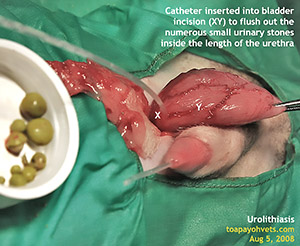 |
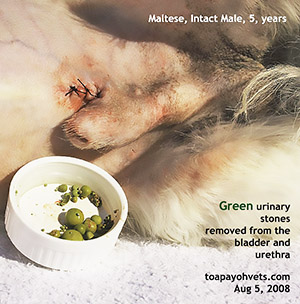 |
|
Cystotomy.
Surgical approach in this case was via the dorsal wall of the bladder as
contrasted to the ventral approach in the Miniature Schnauzer case of the
young lady.
Both approaches are acceptable. The ventral approach is easier, in my opinion. Some vets believe that there will be less pressure on the bladder if the dorsal approach is used. |
|
UPDATE ON AUG 9, 2008 The urinary stones in this Maltese were removed by cystotomy. However, there is no guarantee that he will not get a similar problem another time. X-rays after the surgical removal of stones and every 3-6 months are ideal. 2-weekly urine tests for the next 3 months are recommended to check for bacterial infection and crystal formation. Absence of crystals in the urine or X-rays do not mean that the dog has no stones (>100 numerous green ones). Lessons from this case: 1. On discharge of this Maltese, Vet 2 should give the owner a letter to be signed by the owner saying that he has had been informed of the diagnosis of urethral obstruction. 2. The letter should state that the owner did not want further tests such as X-rays and blood tests and reviews. 3. The prognosis is death if treatment is not given to remove the stones. 4. There is no guarantee that urinary stones will not form again. 5. Regular 3-monthly reviews - urine analysis, blood tests and X-rays at 6-monthly intervals are required to check whether new stones have formed. 6. Post-surgical X-rays may be required to show the client that all stones had been removed. This adds to the costs and many owners are not keen to pay for additional veterinary costs in 2008 due to the ever increasing costs of living in Singapore. 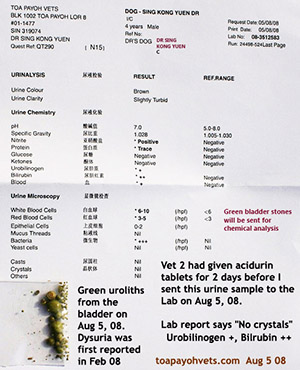 UPDATE AS AT SEP 12, 2009 The Maltese was adopted by a dog lover who has a female Maltese, some 2 weeks ago. On Wednesday Sep 10, 2008, the Maltese had a seizure for around 3-5 minutes and was brought to the Surgery in the evening. He was warded for the next 36 hours and had no seizure. He was extremely energetic. The cause of seizures are not easy to say. He did have a seizure prior to his urethral obstruction according to the son of the patriarch who did not want him. Therefore this is his second seizure. "Could he be having too much sex?" the new owner surprised me with his observation that the Maltese had been trying to mate the female Maltese. Both were sniffing each other for the past few days but she did not permit him to mount her. "The female is not receptive for the first 7-10 days of estrus," I said. "So the male must be exhausted. Did he eat?" I asked because this dog might have hypoglycaemia or low blood sugar if he did not eat twice a day. Some small breeds like the Chihuahuas do suffer from such a condition. "The female ate his food in the evening, as he did not eat it. He was not interested in his food." The male Maltese may be getting seizure soon and did not have the appetite. As the cause of seizures are unknown in most cases, it is hard to treat. The Maltese had no seizures for the past 36 hours and went home. "What should I do if he has a seizure again?" the new owner asked. "The dog keeps banging his head on the floor." "For dogs with seizure, try to prevent the dog from injuring himself. For the small breed, it is possible to wrap him in a blanket and protect his head from injury. Give the dog honey on his tongue first. If the seizures contine, the owner should consult the vet. Usually a diazepam rectal tube will stop the recurring fits. The diazepam is squeezed into the dog's rectum after the seizure to prevent further seizures till the visit to the veterinarian. In this Maltese, I suspect that pain, exhaustion or hypoglycaemia could be the cause of the recent seizure. He had been warded in the Surgery for a few weeks till he was adopted 2 weeks ago. He never had fits. Neither did he have the sexual tensions from a female dog in heat. This dog needed to be monitored. As far as more X-rays and urinalysis to monitor the recurrence of bladder stones every half a year, many Singapore dog owners are not willing to spend money and time to consult the vet when their dogs have medical problems. Therefore, they don't do regular monitoring for bladder stones or annual physical examinations or dental work to prevent diseases. It is cheaper to prevent than to treat but many pet owners wait for diseases to occur. And if the dog dies, well, it is the pet at fault. The cost of living for the ordinary people in Singapore goes up every year. So veterinary advices for the pet are frequently ignored as long as the pet has no "illness" such as difficulty in urination. |
|
|
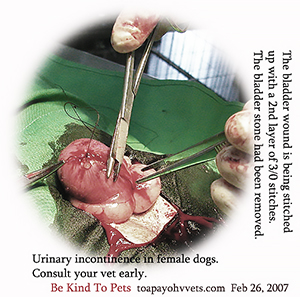 Some
interesting urinary stone cases seen at Toa Payoh Vets by Dr Sing
Kong Yuen Some
interesting urinary stone cases seen at Toa Payoh Vets by Dr Sing
Kong Yuen |